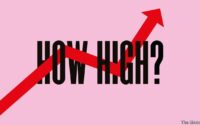The war in Ukraine has highlighted the depth of global connectivity and interdependence, exposed the energy security of Europe, and put the post-Pandemic economic recovery in doubt. However, one of its most important contributions has been to accelerate the post-Covid legacy that is rising inflation. Rocketing energy prices and reports of multiple countries facing a cost-of-living crisis are becoming increasingly difficult to ignore. The real question of the day, however, is centered around whether or not are we heading for stagflation, a policymaker’s worst nightmare. And when it comes to the question of stagflation, there are few factors as important as the EU’s plan to ban Russian oil.
Stagflationary fears are gaining ground, with more than 70 percent of investors expecting an “economic storm“. Even the Treasury Secretary, Janet Yellen, used the term in one of her comments. It should be made clear that there are technically no strict parameters for exactly what stagflation is. There are people, such as New York Times journalist Paul Krugman, who believe that while inflation is a big problem, we are unlikely to see a return to the 1980s. If, when one talks of stagnation, they mean that inflation will persist along with a moderate rise in unemployment, we might be headed towards stagflation, but that isn’t a 1980s-level of stagflation.
The above argument focuses largely on inflation expectations. In 1979 – 80 the inflation rate was 9 percent, and it wasn’t until the subsequent oil price shock that the whole situation was exacerbated. The Fed had to raise interest rates into double digit territory, culminating at 20 percent, which was followed by a recession. Inflation did fall, but unemployment increased, and in 1982 it still stood at a whopping 9.7 percent (it stands at 3.6 percent today).
But such a scenario seems unlikely today. Krugman compares today with the economic situation of 2008 when there was also a recession and unemployment. However, the only difference was that inflation did not persist for as long as it did in the 1980s. This is corroborated by a recent survey released by the Federal Reserve bank of New York that shows consumer expectations regarding inflation spiking in the shorter and near term but subsiding after three years at 3 percent. If this continues to hold true, which will only be possible if there isn’t any new shock to the global economy, then Krugman’s thesis will hold true.

There are two assumptions in the analysis above that dispel fears of a 1980s stagflation:
- (a) Inflation expectations will be low or inflation will come down quickly (leading to the debate of sticky vs flexible inflation).
- (a) There will be no shock to the markets.
The 2nd point will feed into the first. So it is important to assess the possibility of a shock to the world economy. In a replay of the 1980s, the world could experience yet another oil price shock where prices go far beyond 2008 levels. What will cause such a shock? The answer is the EU’s complete ban on Russian oil.
Related: Private Equity Is Back With A Bang In Oil & Gas
Energy prices are already sky-high and commodity markets have seen unprecedented price hikes. Most significantly, global oil inventories are falling. According to Rory Johnston, “global observable” oil inventories have been reduced by 600 million barrels in the last one and a half years – the fastest decline on record. It isn’t only about crude oil either as both distillate and especially diesel stocks are coming under pressure as well.
As Summer Driving Season approaches, analysts have already sounded alarm bells regarding an impending fuel shortage. Hurricane season will make it worse. Since the pandemic, 1 mbpd of refinery capacity has been taken offline and is at its lowest level in the U.S. since 2015. Overall, the U.S. has shaved off 4.5 percent of its refining capacity creating a shortfall of 30 to 35 million gallons per day. About 3 mbpd could still be taken off the markets as Russian output continues to fall. According to IEA, the world will face a supply deficit of about 700,000 bpd in the second quarter of 2022 as OECD inventory levels are at their lowest since 2014. U.S. distillate stocks are reaching a point where they will be at their lowest level in the last 17 years.

As demand rises on the back of China easing its lockdown and Summer Driving Season beginning, a supply crunch will become increasingly likely. A complete ban on Russian oil could then result in an oil price shock that could take prices well above their 2008 highs with some analysts warning of the possibility of oil prices heading towards the $170-$200 range. Gasoline may go all the way up at $10 or more. This will immediately alter point number 1 – consumer inflation expectations. Another way there could be an oil price shock is if Putin ramps up his aggression in Ukraine as Finland and Sweden attempt to join NATO.
There appears to be no end in sight for the Ukrain war and the EU appears determined to ban Russian oil. As demand rises and supply concerns grow, the stage is set for yet another oil price shock, a shock that could very much lead to stagflation last experienced in the early 1980s. Policymakers should not discount such a possibility.
By Osama Rizvi for Oilprice.com
More Top Reads From Oilprice.com:

